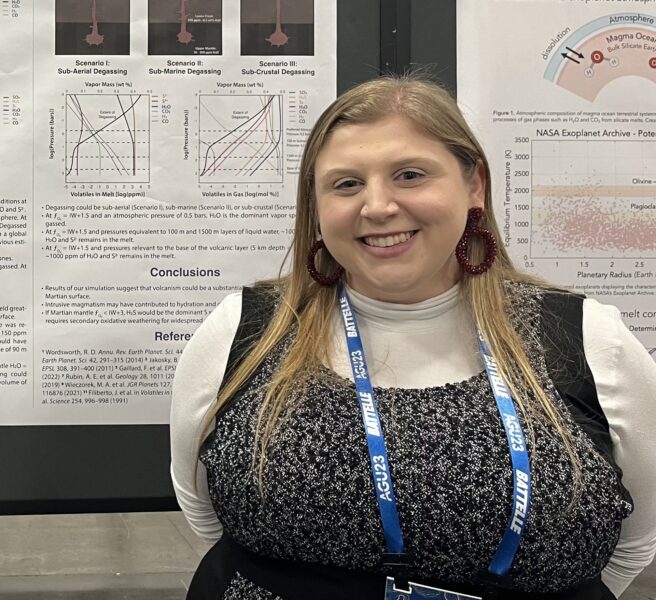CPSH Seminar: Lucia Bellino & Neel Nagarajan
January 27, 2025
JANUARY 27, 2025 at 1:00pm CT
Talk One
Speaker: Lucia Bellino
Title: Volcanic emission of reduced sulfur species shaped the climate of early Mars
Abstract: Sulfur likely played a key role in modulating the climate of early Mars, as evidenced by abundant sulfate deposits on the Martian surface and sulfides in Martian meteorites. Magmatic processes, like mantle melting, magma differentiation, and degassing, were crucial in transporting sulfur from the Martian interior to surface. We simulate sulfur, carbon, and hydrogen degassing with the incorporation of these magmatic processes. We find that evolving Martian magmatic systems primarily degas reduced sulfur species, H2S and S2, and that evolved magmas can reach graphite and sulfide saturation. The degassed reduced sulfur would readily precipitate as sulfide and elemental sulfur, requiring a secondary oxidation mechanism to produce the observed sulfate deposits on the Martian surface. Furthermore, the degassed H2S and S2 could induce a hazy atmosphere on Mars with SF6, a potent greenhouse gas, to shape the climate of early Mars.
Biography: Lucia Bellino is a third year PhD Candidate at the University of Texas at Austin studying volatile cycling on early Mars through high-temperature petrologic processes, such as magmatic degassing. She earned her bachelor’s degree in Geology at Rutgers University in 2021. Under the supervision of Dr. Chenguang Sun here at UT Austin, Lucia uses thermodynamics and experimental petrology to investigate the cycling of hydrogen, carbon, and sulfur from the interior of ancient Mars to its surface to better understand the planet’s paleoclimate and potential habitability.
Talk Two
Speaker: Neel Nagarajan
Title: Simulating the Interior Structure & Thermal Evolution of Earth Like Exoplanets
Abstract: Earth-sized exoplanets that formed relatively early in the universe might be plausible candidates to host life, due to the billions of years that were presumably available for life to develop. Identifying if these planets were habitable at any point could help us estimate when in the lifetime of the universe the first life could have evolved. Such planets would also have different metallicities, quantities of alpha capture elements, and quantities of radioactive species, compared to the Earth. This would lead to different internal planetary structures, in particular lower core/mantle mass ratios and higher quantities of radioactive species such as U_235, U_238, Th_232, and K_40. We attempt to simulate the interior thermal evolution for such planets, using Magrathea to build instantaneous planetary structure models, and VPLanet’s Thermint + Radheat modules to simulate their thermal evolution over billions of years. We deemed our results & procedure as potentially useful in the future, as VPLanet being in its developmental stages is currently hardcoded to contain Earth constants & procedures, and certain modules are not compatible as yet. We plan to preserve our work and revisit it once VPLanet has evolved past the stage of dependence on Earth constants, and become capable of modeling and simulating new planets from the ground up.
Biography: I am Neel Nagarajan, a 1st year astronomy PhD student at the University of California at Los Angeles (UCLA) currently working with Dr. Brad Hansen on exoplanetary orbital dynamics. I grew up pursuing & nurturing my passion for astronomy from the seventh grade onwards, when I studied in a boarding school in India. I graduated in May 2023 with a Bachelor of Science in Astronomy and Physics from the University of Texas at Austin. I currently continue to pursue my passion through my PhD program and love to connect with other individuals to discuss topics in astronomy. My hobbies include long distance running, playing the piano, painting, and Star Wars, and I hope to nurture them further as well in graduate school.


